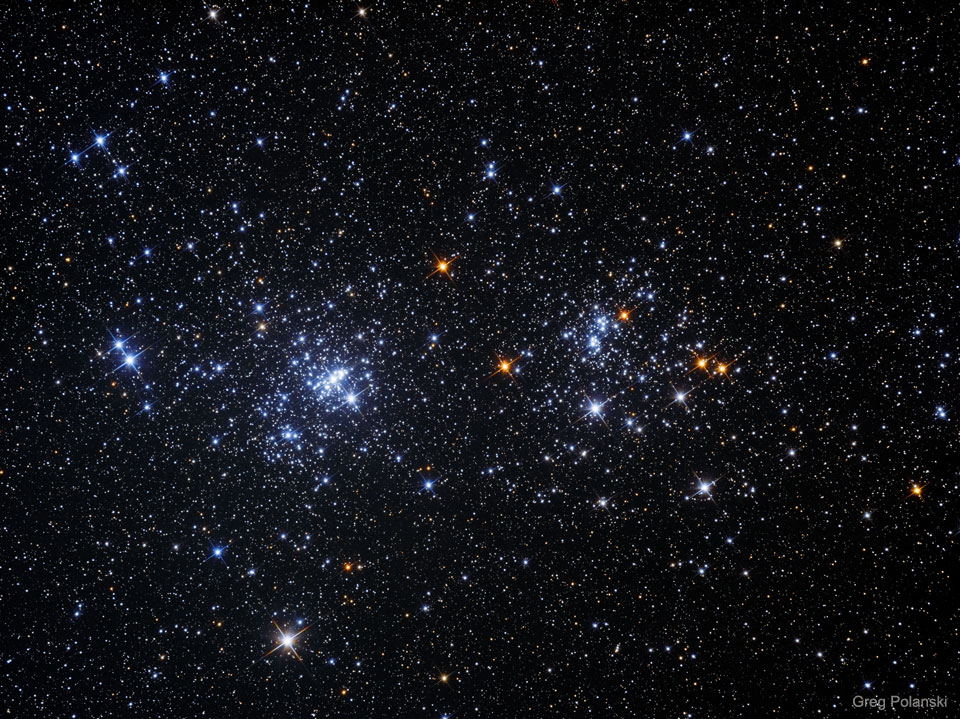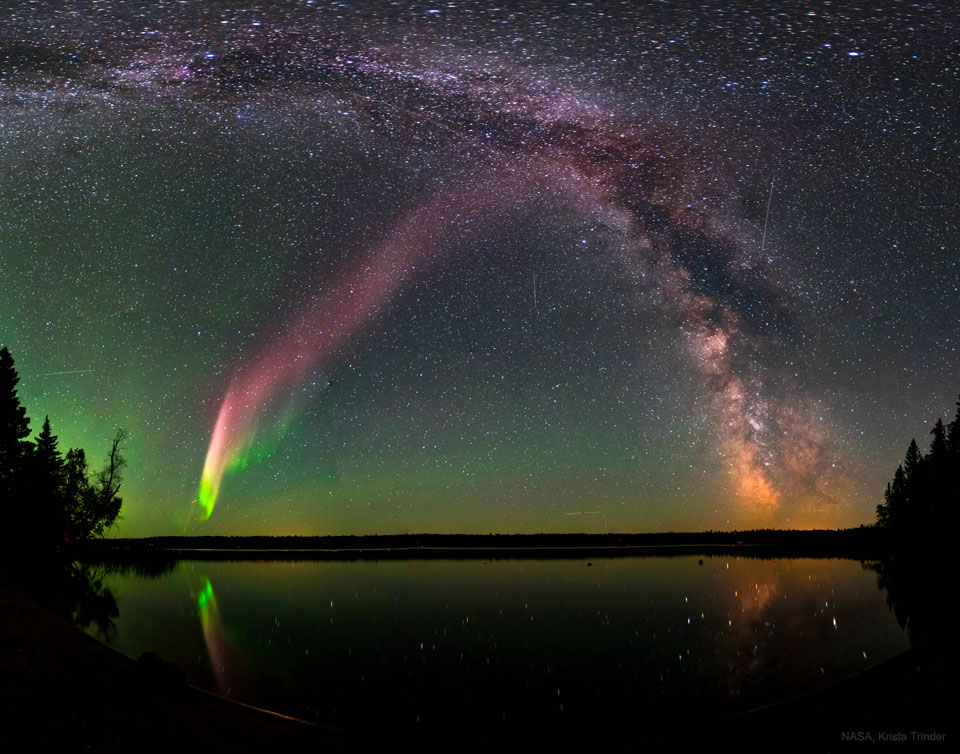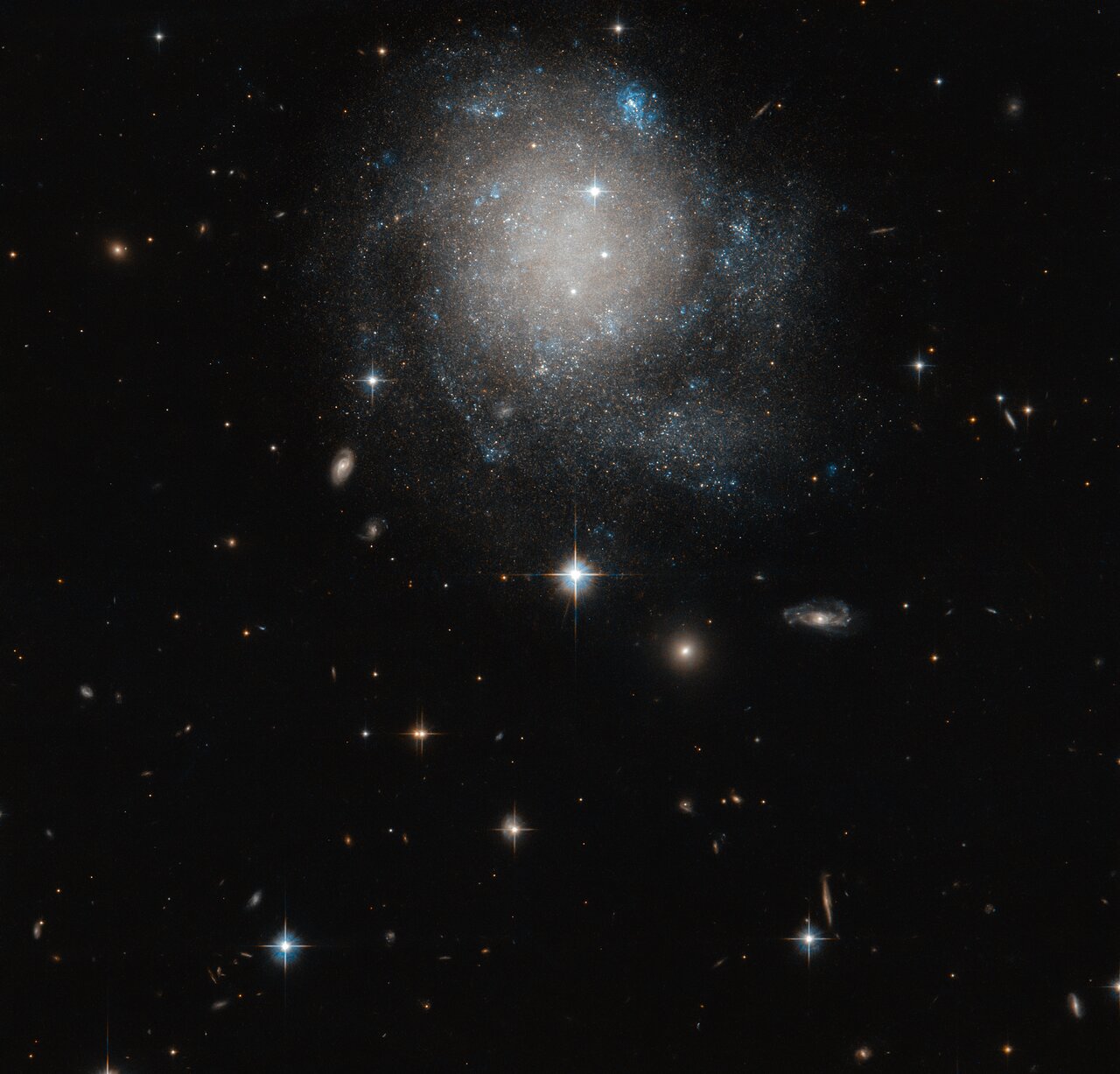Blog
Most star clusters are singularly impressive. Open clusters NGC 869 and NGC 884, however, could be considered doubly impressive. Also known as “h and chi Persei”, this unusual double cluster, shown above, is bright enough to be seen from a dark location without even binoculars. Although their discovery surely predates recorded history, the Greek astronomer Hipparchus notably cataloged the double cluster. The clusters are over 7,000 light years distant toward the constellation of Perseus, but are separated by only hundreds of light years. In addition to being physically close together, the clusters’ ages based on their individual stars are similar – evidence that both clusters were likely a product of the same star-forming region.

Cindy Blackman Santana (born November 18, 1959), sometimes known as Cindy Blackman, is an American jazz and rock drummer. Blackman has recorded several jazz albums as a bandleader and has performed with Pharoah Sanders, Sonny Simmons, Ron Carter, Sam Rivers, Cassandra Wilson, Angela Bofill, Buckethead, Bill Laswell, Lenny Kravitz, Joe Henderson and Joss Stone.
Born November 18, 1959 in Yellow Springs, Ohio, both her mother and grandmother were classical musicians and her uncle a vibist. As a child, her mother took her to classical concerts.
Blackman’s introduction to the drums happened at the age of seven in her hometown of Yellow Springs, Ohio. At a pool party at a friend’s house she saw a drum set and began playing them. “Just looking at them struck something in my core, and it was completely right from the second I saw them”, says Blackman. “And then, when I hit them, it was like, wow, that’s me.”. Soon after, Blackman began playing in the school band and persuaded her parents to get her toy drums.
https://www.youtube.com/watch?v=uwhWbOLztDI
more...Donald Eugene Cherry (November 18, 1936 – October 19, 1995) was an American jazz trumpeter. Cherry had a long association with free jazzsaxophonist Ornette Coleman, which began in the late 1950s. Cherry was also a pioneer in world fusion music in the 1960s and 1970s.
Cherry was born in Oklahoma City, Oklahoma, to a mother of Choctaw descent through his maternal grandmother, and an African-American father.His mother and grandmother played piano and his father played trumpet. His father owned Oklahoma City’s Cherry Blossom Club, which hosted performances by Charlie Christian and Fletcher Henderson. In 1940, Cherry moved with his family to Los Angeles, California. He lived in the Wattsneighborhood, and his father tended bar at the Plantation Club on Central Avenue, which at the time was the center of a vibrant jazz scene. Cherry recalled skipping school at Fremont High School in order to play with the swing band at Jefferson High School. This resulted in his transfer to Jacob Riis High School, a reform school, where he first met drummer Billy Higgins.
https://www.youtube.com/watch?v=AEM-5_nWo9E
more...Claude Berkeley Williamson (November 18, 1926 – July 16, 2016) was an American jazz pianist.
Williamson was born in Brattleboro, Vermont, United States. He studied at the New England Conservatory of Music before moving to jazz, influenced mainly by Teddy Wilson, then by Al Haigand Bud Powell. In 1947, he moved to California, working first with Teddy Edwards, then with Red Norvo in San Francisco, with Charlie Barnet in 1949, and with June Christy for two years. Later he worked with Max Roach, Art Pepper and others. Williamson was a longtime member of the Lighthouse All-Stars (substituting for pianist Russ Freeman), performing with Bud Shank, Stan Levey, Bob Cooper, Conte Candoli and Howard Rumsey. In 1956, he became the piano player in the Bud Shank quartet. In 1968, he started working as a pianist for NBC, first on The Andy Williams Show, then for Sonny and Cher. In 1978, Williamson went back to the jazz world and released many albums, mainly for Japanese labels, often accompanied by Sam Jones and Roy Haynes. In 1995 he made a trio recording for Fresh Sound Records at the Jazz Bakery in Los Angeles.
more...Máximo Francisco Repilado Muñoz Telles (18 November 1907 – 13 July 2003), known professionally as “Compay Segundo“, was a Cuban trovaguitarist, singer and composer.
Compay (meaning compadre) Segundo, so called because he was always second voice in his musical partnerships, was born in Siboney, Cuba, and moved to Santiago de Cuba at the age of nine. His first engagement was in the Municipal Band of Santiago de Cuba, directed by his teacher, Enrique Bueno. In 1934, after a spell in a quintet, he moved to Havana, where he also played the clarinet in the Municipal Band. He also learned to play the guitar and the tres, which became his usual instruments. Compay Segundo also invented the armónico, a seven-stringed guitar-like instrument, to fill the harmonic jump between the Spanish guitar and the tres. In the 1950s he became well known as the second voice and tres player in Los Compadres, a duo he formed with Lorenzo Hierrezuelo in 1947.
Los Compadres were one of the most successful Cuban duos of their time. Greater international fame came later, in 1997, with the release of the Buena Vista Social Club album, a hugely successful recording which won several Grammy awards. Compay Segundo appeared in the Wim Wenders film of the same title.
more...https://www.youtube.com/watch?v=av9mLAvVGEE&list=PLEB3LPVcGcWZ0hsQ5_jgSMhawAnDzy1io&index=13
more...Hey you guys I need some hits on this YouTube video from Club Calabash. Help out de Idren and click on de ting! Thanx
more...https://www.youtube.com/watch?v=rvwfLe6sLis
more...Known as Strong Thermal Emission Velocity Enhancements (STEVEs), these luminous light-purple sky ribbons may resemble regular auroras, but recent research reveals significant differences. A STEVE‘s great length and unusual colors, when measured precisely, indicate that it may be related to a subauroral ion drift (SAID), a supersonic river of hot atmospheric ions thought previously to be invisible. Some STEVEs are now also thought to be accompanied by green picket fence structures, a series of sky slats that can appear outside of the main auroral oval that does not involve much glowing nitrogen. The featured wide-angle composite image shows a STEVE in a dark sky above Childs Lake, Manitoba, Canada in 2017, crossing in front of the central band of our Milky Way Galaxy.

Phil Parnell is a freelance pianist, producer and songwriter from New Orleans, based in Denmark. He has enjoyed 35 years in the music business performing around the globe with artists from cutting edge of the music spectrum to torchbearers from Storyville’s heyday and nearly everything in-between! Diversity has kept him involved in so many projects, which in turn has kept his keen musical perspective and enthusiasm alive over the years.
In the 1970’s he was a piano student of Ellis Marsalis’ before attending Berklee College of music in Boston. His musical education continued in the blues and jazz clubs of New Orleans working with many old school musicians like Freddy Kohlmann, David Lastie, Gatemouth Brown, and Justin Adams. He has performed on stage with such notables as Bettye Lavette, Astrud Gilberto, Brian Blade, George Porter jr. (of the Meters), Bo Diddly, Imelda May, Jamie Lidell, Matthew Herbert, John & Lillian Boutte’ and Oscar Brown jr all from whom he has drawn influence and inspiration.
Recent highlights of Phil’s career include: ‘PP3_Blue’ the 2nd CD release for his eclectic 3-tet ‘PP3’. Recording ‘Normalment Plan Bar’, an experimental CD with ‘FR::YK’, a Swiss electronic music project in Valais CH. Recording at Abbey Road studios and subsequent touring with the Matthew Herbert Big Band ‘There’s Me And There’s You’ CD (with the Phil Parnell Trio being drafted in to fill the rhythm section chairs). World tour with nouveau soul singer/songwriter Jamie Lidell and opening for Elton John’s Red Piano tour. Appearing with Lillian Boutte’ in a live performance his song ‘Party All My Troubles Away’ in the 2009 Zurich Film festival documentary category winner “The Sound After the Storm” about New Orleans musicians after hurricane Katrina.
more...Gordon Meredith Lightfoot Jr. CC OOnt (born November 17, 1938) is a Canadian singer-songwriter and guitarist who achieved international success in folk, folk-rock, and country music. He is credited with helping to define the folk-pop sound of the 1960s and 1970s. He is often referred to as Canada’s greatest songwriter and is known internationally as a folk-rock legend.
Lightfoot’s songs, including “For Lovin’ Me”, “Early Morning Rain“, “Steel Rail Blues”, “Ribbon of Darkness“—a number one hit on the U.S. country chart with Marty Robbins‘s cover in 1965—and “Black Day in July” about the 1967 Detroit riot, brought him wide recognition in the 1960s. Canadian chart success with his own recordings began in 1962 with the No. 3 hit “(Remember Me) I’m the One”, followed by recognition and charting abroad in the 1970s. He topped the US Hot 100 or AC chart with the hits “If You Could Read My Mind” (1970), “Sundown” (1974); “Carefree Highway” (1974), “Rainy Day People” (1975), and “The Wreck of the Edmund Fitzgerald” (1976), and had many other hits that appeared in the top 40.
Several of Lightfoot’s albums achieved gold and multi-platinum status internationally. His songs have been recorded by renowned artists such as Elvis Presley, Johnny Cash, Hank Williams Jr., The Kingston Trio, Marty Robbins, George Hamilton IV, Jerry Lee Lewis, Neil Young, Bob Dylan, Judy Collins, Barbra Streisand, Johnny Mathis, Herb Alpert, Harry Belafonte, Scott Walker, Sarah McLachlan, Eric Clapton, John Mellencamp, Jack Jones, Bobby Vee, Roger Whittaker, Tony Rice, Peter, Paul and Mary, Glen Campbell, The Grateful Dead, The Irish Rovers, Nico, Olivia Newton-John, Paul Weller, Nine Pound Hammer, Ultra Naté, The Tragically Hip, The Unintended and Headstones.
more...Imrat Khan (17 November 1935 – 22 November 2018) was an Indian sitar and surbahar player and composer. He was the younger brother of sitar maestro Ustad Vilayat Khan.
Imrat Khan was born in Calcutta on 17 November 1935 into a family of musicians tracing its roots back for several generations, to the court musicians of the Mughal rulers. The training in music traditionally has been passed down from father to son for nearly 400 years. He belongs to Etawah gharana also known as Imdadkhani gharana of classical musicians. Imrat Khan’s father was Enayat Khan (1895–1938), recognised as a leading sitar and surbahar player of his time, as had been his grandfather, Imdad Khan (1848–1920), before him. Imrat Khan’s father died when Imrat was a child, so he was raised by his mother, Bashiran Begum and her father, singer Bande Hassan Khan. In 1944, the family moved with Vilayat Khan, Imrat’s older brother, to Bombay where both the brothers learned sitar-playing extensively from their uncle Wahid Khan. In 1952, Vilayat and Imrat moved in together in Calcutta. They performed together for many years. The two brothers were part of the first cultural delegation to the Soviet Union and Eastern Europe in 1956.
more...David Werner Amram III (born November 17, 1930) is an American composer, arranger, and conductor of orchestral, chamber, and choral works, many with jazz flavorings. He plays piano, French horn, Spanish guitar, and pennywhistle, and sings. Amram has also composed scores for films, and has led quartets, quintets and larger ensembles who perform and record under his name.
Amram studied at the Oberlin Conservatory of Music in 1948–1949, and earned a bachelor’s degree in European history from George Washington University in 1952. In 1955 he enrolled at the Manhattan School of Music, where he studied under Dimitri Mitropoulos, Vittorio Giannini, and Gunther Schuller. Under Schuller he studied French horn.
Amram is a strong advocate for music education of the young. For over a quarter-century he served as music director for youth and family concert programs for the Brooklyn Philharmonic. Amram has pointed out: “It is tremendously important for professional people to work with the young. That is the way a true music culture is created — not through merchandising, but through love.”
As a sideman or leader, Amram has performed and/or recorded with such jazz and classical figures as Aaron Copland, Thelonious Monk, Dizzy Gillespie, Charles Mingus, Jack Kerouac, Sonny Rollins, Lionel Hampton, Stan Getz, George Barrow, Jerry Dodgion, Paquito D’Rivera, Pepper Adams, Arturo Sandoval, Oscar Pettiford, Allen Ginsberg, Mary Lou Williams, Kenny Dorham, Ray Barretto, Wynton Marsalis, and others. He has also worked with a wide range of folk, pop, and country figures, such as Bob Dylan, the Roche sisters, Pete Seeger, Odetta, Willie Nelson, Oscar Brand, Judy Collins, Peter Yarrow, Tom Paxton, Phil Ochs, Josh White, Patti Smith, Arlo Guthrie, and others.
more...Roswell Hopkins Rudd Jr. (November 17, 1935 – December 21, 2017) was an American jazz trombonist and composer.
Although skilled in a variety of genres of jazz (including Dixieland, which he performed while in college), and other genres of music, he was known primarily for his work in free and avant-garde jazz. Beginning in 1962 Rudd worked extensively with saxophonist Archie Shepp.Rudd was born in Sharon, Connecticut on November 17, 1935. He attended the Hotchkiss School and graduated from Yale University, where he played with Eli’s Chosen Six, a dixieland band of students that Rudd joined in the mid-1950s. The sextet played the boisterous trad jazz style of the day, and recorded two albums, including one for Columbia Records. His collaborations with Shepp, Cecil Taylor, John Tchicai, and Steve Lacy grew out of the lessons learned while playing rags and stomps for drunken college kids in Connecticut. Rudd later taught ethnomusicology at Bard College and the University of Maine.
more...https://www.youtube.com/watch?v=iwQhMIik3JQ&list=PLEB3LPVcGcWZ0hsQ5_jgSMhawAnDzy1io&index=14
more...Observed with the NASA/ESA Hubble Space Telescope, the faint galaxy featured in this image is known as UGC 12588. Unlike many spiral galaxies, UGC 12588 displays neither a bar of stars across its centre nor the classic prominent spiral arm pattern. Instead, to a viewer, its circular, white and mostly unstructured centre makes this galaxy more reminiscent of a cinnamon bun than a mega-structure of stars and gas in space.
Lying in the constellation of Andromeda in the Northern hemisphere, this galaxy is classified as a spiral galaxy. Unlike the classic image of a spiral galaxy, however, the huge arms of stars and gas in UGC 12588 are very faint, undistinguished, and tightly wound around its centre. The clearest view of the spiral arms comes from the bluer stars sprinkled around the edges of the galaxy that highlight the regions where new star formation is most likely taking place.

Diana Jean Krall OC OBC (born November 16, 1964) is a Canadian jazz pianist and singer, known for her contralto vocals. She has sold more than 6 million albums in the US and over 15 million albums worldwide. On December 11, 2009, Billboard magazine named her the second Jazz Artist of the Decade (2000–09), establishing her as one of the best-selling artists of her time.
Krall is the only jazz singer to have had eight albums debuting at the top of the Billboard Jazz Albums. To date, she has won three Grammy Awardsand eight Juno Awards. She has also earned nine gold, three platinum, and seven multi-platinum albums.
https://www.youtube.com/watch?v=OLL4BhsaFRE
more...More Posts
- World Music with Obo Addy
- Daily Roots with Bob Marley
- The Cosmos with Fleming 1
- Ernest Ranglin Day
- Billy Drummond Day
- World Music with Lela Tataraidze
- Daily Roots with the Skatalites
- The Cosmos with NGC 6872 & IC 4970
- Paul McCartney Day
- William Hooker Day
- Rudy Rutherford Day
- World Fusion with Manika Kaur
- Daily Roots with the Congos
- Happy Fathers Day 2018
- The Cosmos with RCW 108
- Chuck Rainey Day
- Sing Miller Day
- World Music with Corvus Corax
- Daily Roots with ITSJAHMIEL
- The Cosmos with NGC 3372